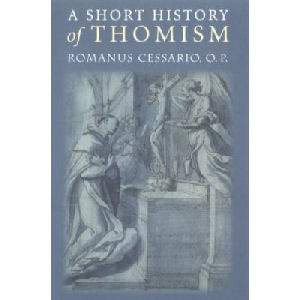
|
Posted April 22, 2005
Book: A Short History of Thomism Author: Romanus Cessario, O.P. The Catholic University of America Press, Washington, D.C., Pp. 106 An Excerpt from the Jacket:
The author, who has worked in the field for more than thirty-five years, brings to his study an appreciation for the place that Saint Thomas Aquinas holds as a perennial teacher of Christian theology, and for the influence that the Common Doctor has exercised on all stripes of theology and philosophy. An Excerpt from the Book: The Thomists In one sense, Thomas Aquinas can claim no immediate disciples. The Dominican friars who succeeded to his chair at Paris, Hannibal de Hannibaldis (d. 1272) and Romanus of Rome (d. 1273)’ both preceded him in death, and neither, in any event, seems to have fathomed the innovations that Aquinas had introduced into theology. His faithful secretary and confessor, Reginald of Piperno, was content, so it appears, with receiving abridged forms of his master’s theological opera, and there is nothing, moreover to indicate that he considered himself to be the leader of a newly formed Thomist school. Even those who reasonably may be numbered among the first practicing Thomists, William of Macclesfeld, Giles of Lessines, Bernard of Trilia, and Rambert of Primadizzi, never studied directly under Aquinas. As it happened, Thomism took root and developed amidst controversy rather than form within a circle of supportive friends. Negative reactions to Aquinas’s “innovations,” as adherents to the old Augustinian tradition described them, began even during the saint’s own lifetime. Aquinas’s acceptance of the new Aristotelian learning provoked suspicions that the Dominican master held common ground with the Latin followers of the Spanish Islamic philosopher Averroes, even though Aquinas himself had already exposed the errors of the Averroists that were contrary to the truth of the Catholic religion. So when in 1270, the bishop of Paris, Stephen Tempier, proscribed thirteen problematic theses, whose immediate provenance was the Arts Faculty at Paris, the condemnation cast into a still more unfavorable light the systematic use of Aristotle that Aquinas had introduced into theological debate. Specific issues that fell under Tempier’s proscription included the denial both of universal hylomorphism and of the plurality of substantial forms. The Paris ordeal confirms that, in this initial period of Thomism, Aquinas’s willingness to dispense with certain older philosophical theories provoked the strongest reactions against his way of doing theology; and, as his opponents included important ecclesiastics, these early protests nearly threatened to subvert the progress of his intellectual achievement. Negative reaction, however, to Aquinas’s deployment of Aristotelianism did not stem from disagreement concerning the intrinsic merit of one philosophical viewpoint over another. It happened because it was believed that philosophical theses such as the aforementioned were inextricably bound up with expressing certain truths of the Christian faith. To the extent that Aquinas’s antagonists held by and large to the older Augustinian tradition, influenced in some measure by the Fons vitae of Avicebron, the condemnation of 1270 can safely be said to mark the beginning of the inter-scholas debates between Thomists and other traditions in theology. That Bishop Tempier’s action was strongly supported by the Franciscans, especially by John Peckham and perhaps even by Saint Bonaventure himself, lends credence to such an historical judgement. Furthermore, this early Franciscan opposition to Aquinas presages later difficulties over theological models between the two mendicant groups. Aquinas’s death did nothing to assuage official fears about his doctrines and his use of Aristotelian philosophy in theology. For shortly afterwards, ecclesiastical authorities in both France and England renewed their condemnations of those theses that seemed to depart from the standard philosophical positions of the old Augustinian school. Thomas Gilby observes that “many of the points at issue were highly technical, and some of them may now seem even trivial; the debate, much of which Thomas himself anticipated in his Questiones Quodibetales, revolves round what to him were contrasts — but to his critics were conflicts — between nature and grace, reason and faith, determinism and freedom, the existence of the universe from eternity and its beginning in time, the soul as biological form and spirit, and the role of the senses and of divine enlightenment in the acquisition of knowledge. It is worthy of note that the first person to undertake a defense of Aquinas at Paris was his former teacher, Albertus Magnus, who traveled thence in the winter of 1276-77, though to no avail since Bishop Tempier had by the time Albert’s arrival already issued a further condemnation, this time including 219 propositions thought to jeopardize authentic instruction in the Christian religion. The large majority of these theses wee associated not with Thomas Aquinas himself but with radical Aristotelians like Siger of Brabant, who were heavily influenced by the commentatorial tradition of Averroes. Table of Contents: One. Thomism 1. Who is Thomas Aquinas? 2. Speaking about Thomism 3. Customary divisions in the history of Thomism 4. A new conception of this history Two. The Thomists Three. After the French Revolution |
|
